PAMUKKALE & CULTURAL 4 DAYS / 3 NIGHTS
Pamukkale 4 days tour from Antalya is a cultural tour to the ancient city of Hierapolis, world-famous Travertines (calcium terraces) and unusual places unknown to the public... More information in the description below.
- Category: DAİLY EXCURSİONS & PACKAGES TOUR TURKEY
- Service Length: 45 Minutes
- Price:Free
Description
Pamukkale 4 days tour from Antalya is a cultural tour to the ancient city of Hierapolis and world-famous Travertines (calcium terraces) with 3 nights accommodation in Pamukkale.
Pamukkale is a district of Denizli Province which is about 230 km away from Antalya. The calcium terraces called Pamukkale which means 'cotton castle' in Turkish languages.
it is known as one of the oldest thermal cities in the world. Pamukkale 's thermal waters (about 30 degrees) which have been always attracted its visitors with its beauty and health purposes for centuries.
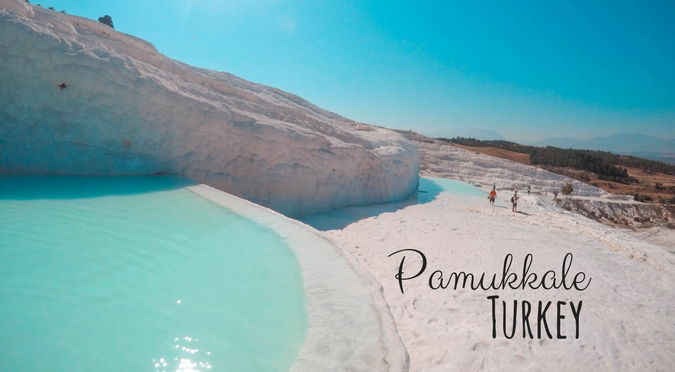
Pamukkale is a tourism trademark of Turkey as Antalya. The area also is at the list of UNESCO heritage. Don't miss seeing this unique attraction of Turkey while your holiday in Antalya.
PAMUKKALE & CULTURAL 4 DAYS TOUR FROM ANTALYA ITINERARY:
DAY 1 :
Pick-up from hotels
Travel over the Taurus mountain
Breakfast along the way
Our first visit will be Salda Lake
Lake Salda
NASA: Lake Salda in Turkey is similar to Jezero Crater on Mars
In a Twitter post, NASA has pointed out the similarities between Lake Salda in Turkey and the Jezero Crater on Mars: "It shares similar mineralogy and geology as the dry Martian lakebed."
According to the NASA researchers, Turkey's Lake Salda shares similar mineralogy and geology as the dry Martian lakebed and it is, in fact, "the only known lake on Earth that contains the carbonates and depositional features (deltas) similar to those found at Jezero Crater."
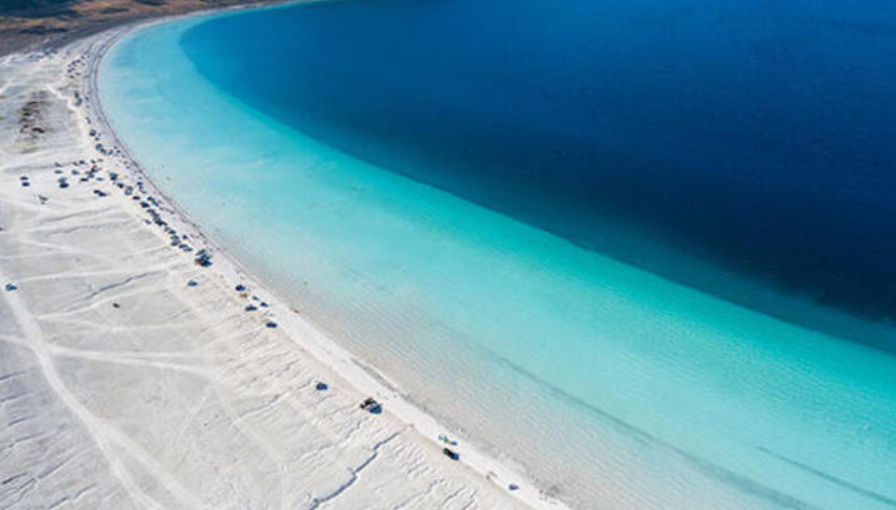
We will give you around 1 hour 30 minutes of free time to enjoy the crystal-clear water of Salda.
Departure for the rest of the day and meal along the way
Our second visit will be Kaklik Cave. The sulphurous water and structure of this cave, which is a cave version of Pamukkale's travertines, will catch your eye. We recommend that you wear suitable shoes to prevent your feet from getting wet when walking.
Kaklik Cave
Kaklik Cave - or under ground Pamukkale.
Pamukkale has a world-wide reputation. Kaklik Cave on the other hand is less known. It has been discovered in recent years.
Kaklık cave, is uniquely beautiful in respect of its formation and development feature as well as its interesting travertines and pools similar to Pamukkale, and dripstones, stalactites and stalagmites.
Due to both underground stream that flows through the cave and the spring that has come out beside the cave and has let some of its water into the cave close masses and petty small foliate ivy-like plants have grown on the walls of hydrologically active Kaklık cave, that receive direct sun light and permanently drip and leak.
These plants that take on different tones of green during the day depending on the light contribute a distinct beauty to the cave.
The almost whole area of the main gallery is covered with travertines with marvellous colors that are formed by the spring water that comes out outside the cave by waterfalls.
These white travertines that develop in pools in the form of steps and that develop on these blocks according as a result of the collapse of the ceiling is a small miniature of Pamukkale.
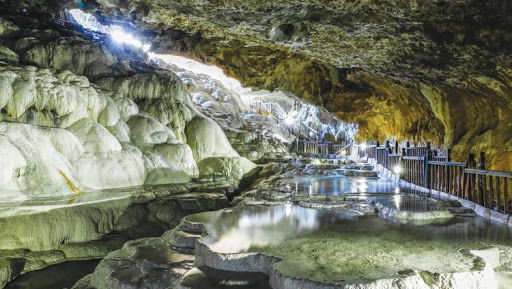
Arrival to Denizli. Installation at the hotel and free time
Dinner and overnight accommodation
DAY 2 :
Having breakfast in the hotel
Spa relaxation day and discovery of Karahayit Redwater
Karahayıt Hot Springs are located in Denizli Karahayıt District. The temperature of the unique red healing thermal water and thermal mud from its main source in all seasons of the year is 58 C and according to the report of the Institute of Hydroclimatology at Ege University, it is is a unique health resource with its rich minerals.
Thanks to the red water and thermal mud, many diseases and health problems can be cured in the tourist facilities (hotels, aparthotels and hostels) of Karahayıt
Diseases treated in Karahayıt hot springs
Diseases treated with bath applications: In rehabilitation and complementary treatment of orthopedic and neurological sequelae, rheumatic diseases, sciatica, lumbar neck hernia, calcification, diseases of the circulatory system and sedation ( mental relief), diseases requiring neurological rehabilitation, postoperative stiffness and stiffness. Rehabilitation of gynecological diseases, stress and stress-related diseases, insomnia and fatigue, regeneration of hair, nails and skin cells, skin and skin diseases, elimination of contractures that develop after plaster removal from fractures, relief of muscle spasms, gout disease, neuralgia, neuritis, osteoarthritis, treatment of colitis diseases.
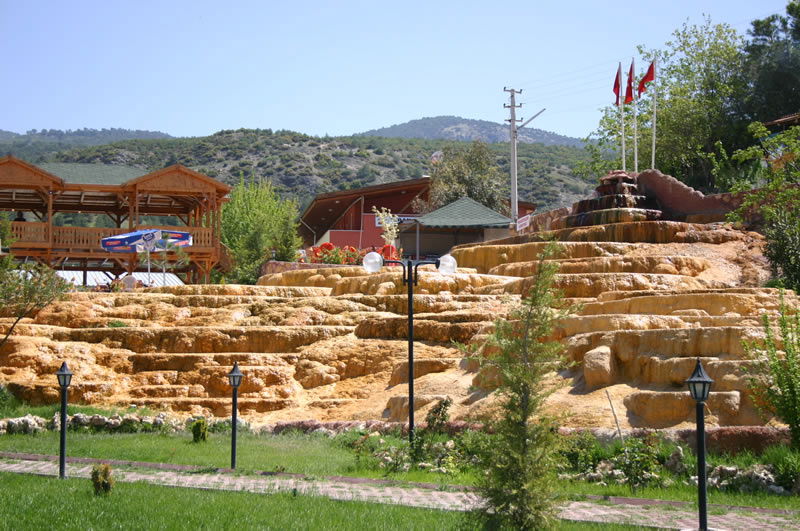
Diseases treated with drinking water: It has been indicated that it can be used as an adjunct to treatment in functional disorders of the upper gastrointestinal system, disorders of the stomach and esophagus, bone resorption , urolithiasis and calcium requirements.
In addition, it has the properties of softening the skin with a mud bath, opening the pores, treating and recovering cellulite and cracks, eliminating acne and pimples with its antiseptic effect, d 'eliminate wrinkles and cure warts.
Red water and thermal mud; kidney stones, heart, arteriosclerosis, high blood pressure, rheumatism, sciatica, calcification, gynecological and skin diseases, hernia of the waist and neck, digestion, stomach, intestine, liver, bile ducts, diabetes, eczema, increased body resistance, metabolic disorders It has been shown to be extremely curative.
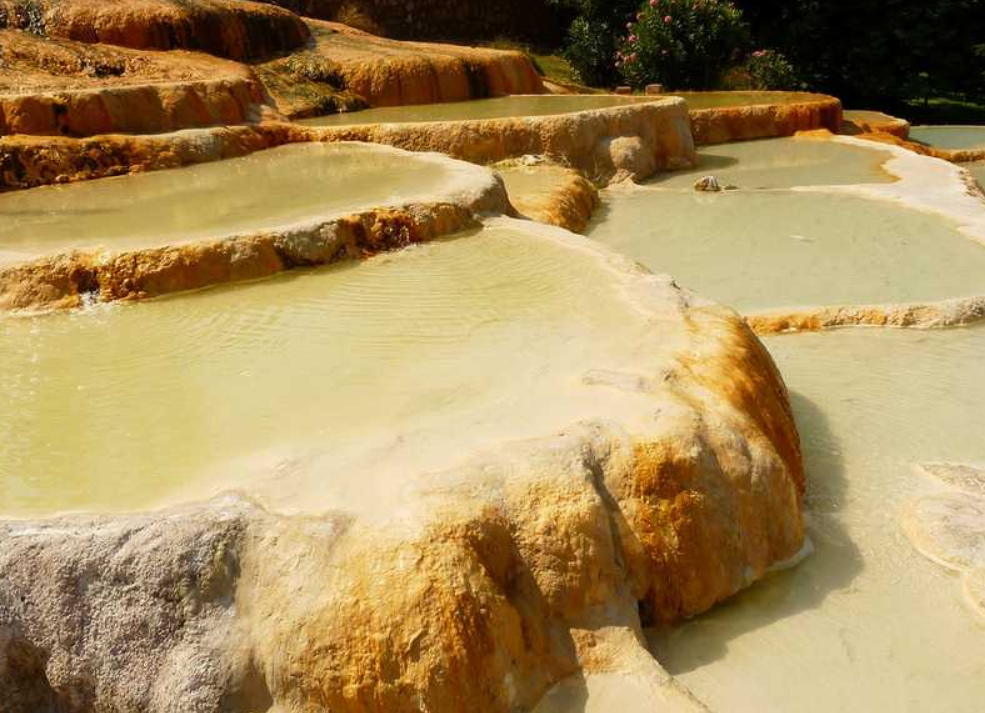
Karahayıt Red Water Travertines
Red water travertines form in the form of layers of red, green and white colored travertine due to mineral oxides in thermal water, around thermal water at 60 ° C.
After our day of spa relaxation, departure for the Bağbaşı plateau
we take a cable car to Bağbaşı plateau where we can see Denizli from a bird's eye view and enchant us with its fresh air. We return to our hotel after a good time spending here.
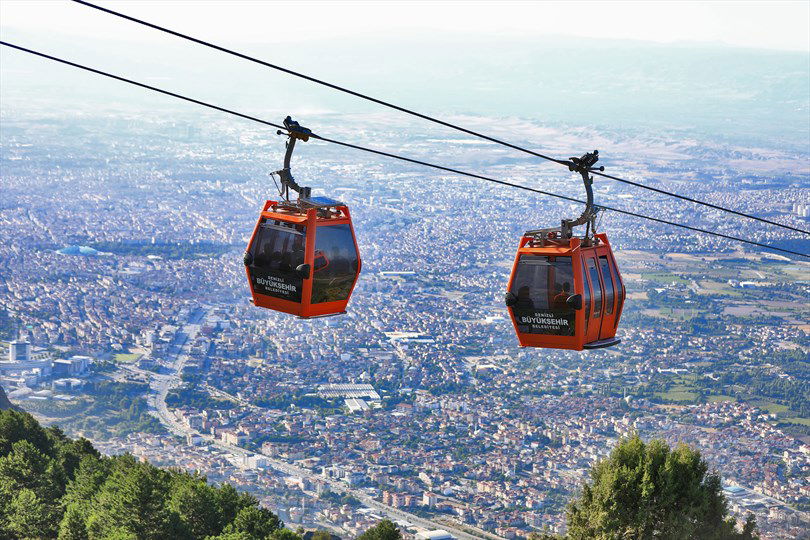
Free Time
Dinner and overnight accommodation
DAY 3 :
Having breakfast in the hotel
Day to Pamukkale and Hierapolis Historic Sites
Pamukkale and visiting limestone terraces
Pamukkale poetically means "cotton castle". This amazing geological formation originates from the many hot springs in the area. These infiltrate the limestone rock and are therefore enriched with minerals and also CO2. By various chemical reactions, calcium carbonate is deposited on the reliefs of the hill.
After evaporation, this forms a solid and white layer. Many basins forming natural swimming pools follow one another in this way. Once filled by the springs, they overflow, thus creating waterfalls petrified with the same calcium carbonate.
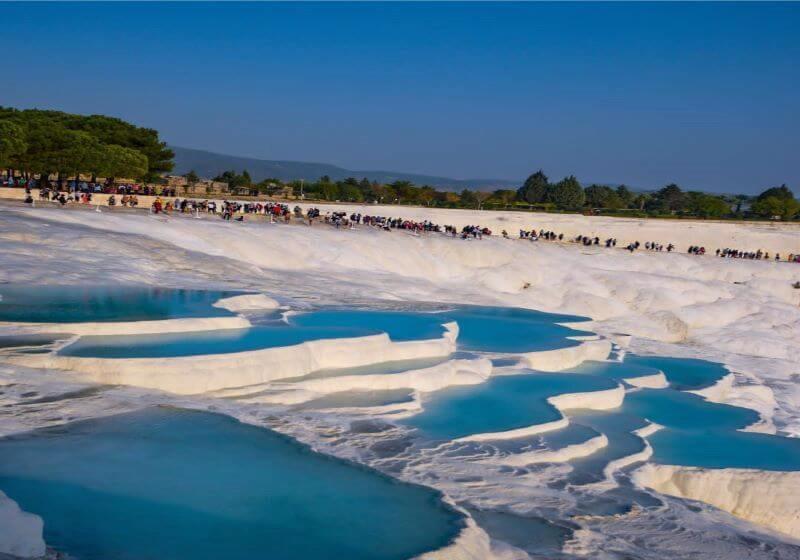
To give you an idea of its size, it measures 2700m long, 160m high. It is therefore widely visible from the village. From a distance, it is reminiscent of a glacier fallen from the sky or of whipped cream that has flowed (it all depends on your level of poetry).
Visit the ancient city of Hierapolis
Hierapolis is an ancient city located on the top of Pamukkale and is a World Heritage site. There is a mixture of Pagan, Roman, Jewish and early Christian influences. Since the hot springs of Pamukkale were used as a spa since the 2nd century, people came to Hierapolis to soothe their ailments and often retire and die. The ruins sprawl over a large area and there is a large necropolis filled with sarcophagi.
The baths were made from large stone blocks and there are various open and closed areas linked together. The complex was constructed in the 2nd century and there are few historical facts known about the origin of the city. Many of the statues were transported to museums across the world and in 1970 a museum was built onsite.
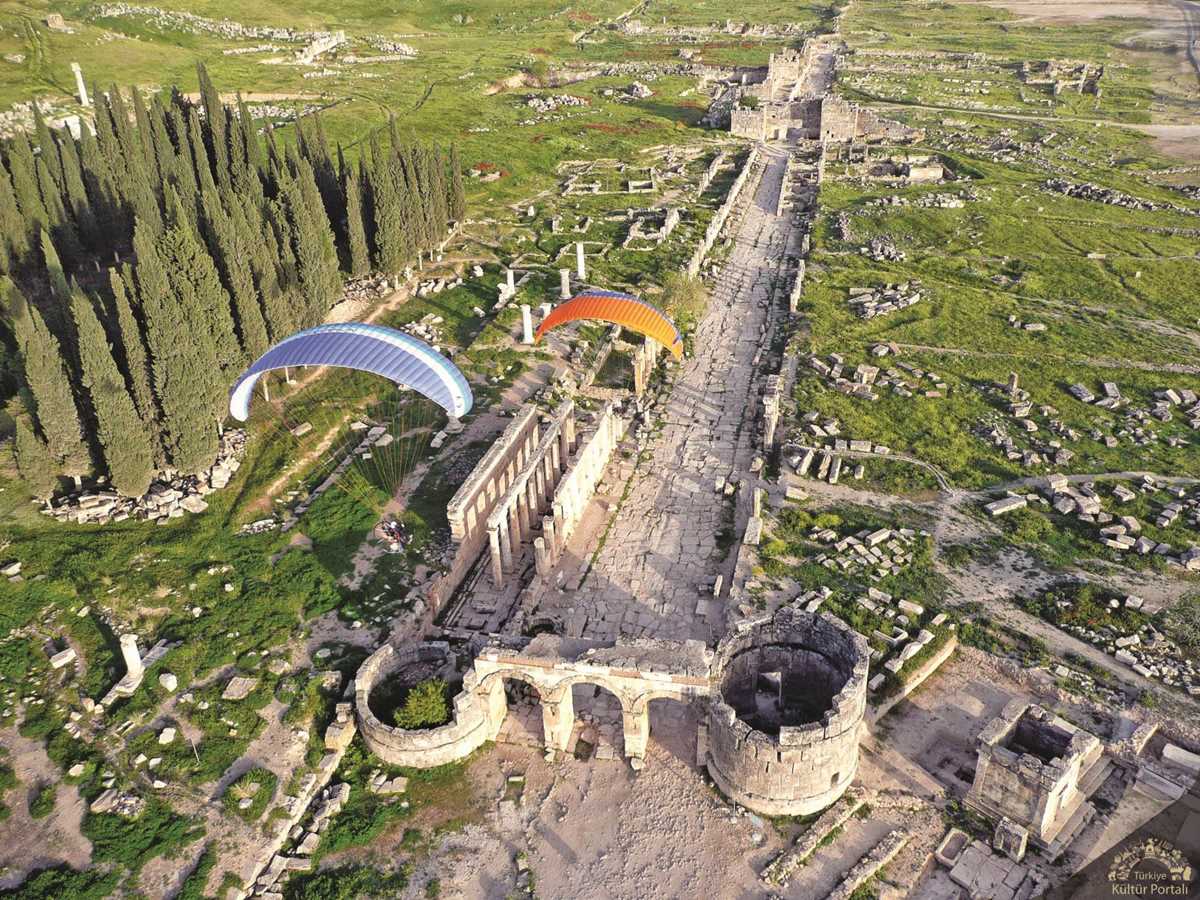
MAIN SIGHTS
ROMAN THEATRE
The Roman Theatre was built over two stages; the first theatre was destroyed by an earthquake, so the second was hollowed out of a slope in the mountain. Most of the stage is still visible, as well as some decorative panels and VIP seating areas.
At full capacity, the theatre could hold 12,000 – 15,000 people. The theatre is divided by eight vertical passageways and nine aisles. The theatre is constantly undergoing excavation projects and new relics and statues depicting mythological figures are continually being discovered.
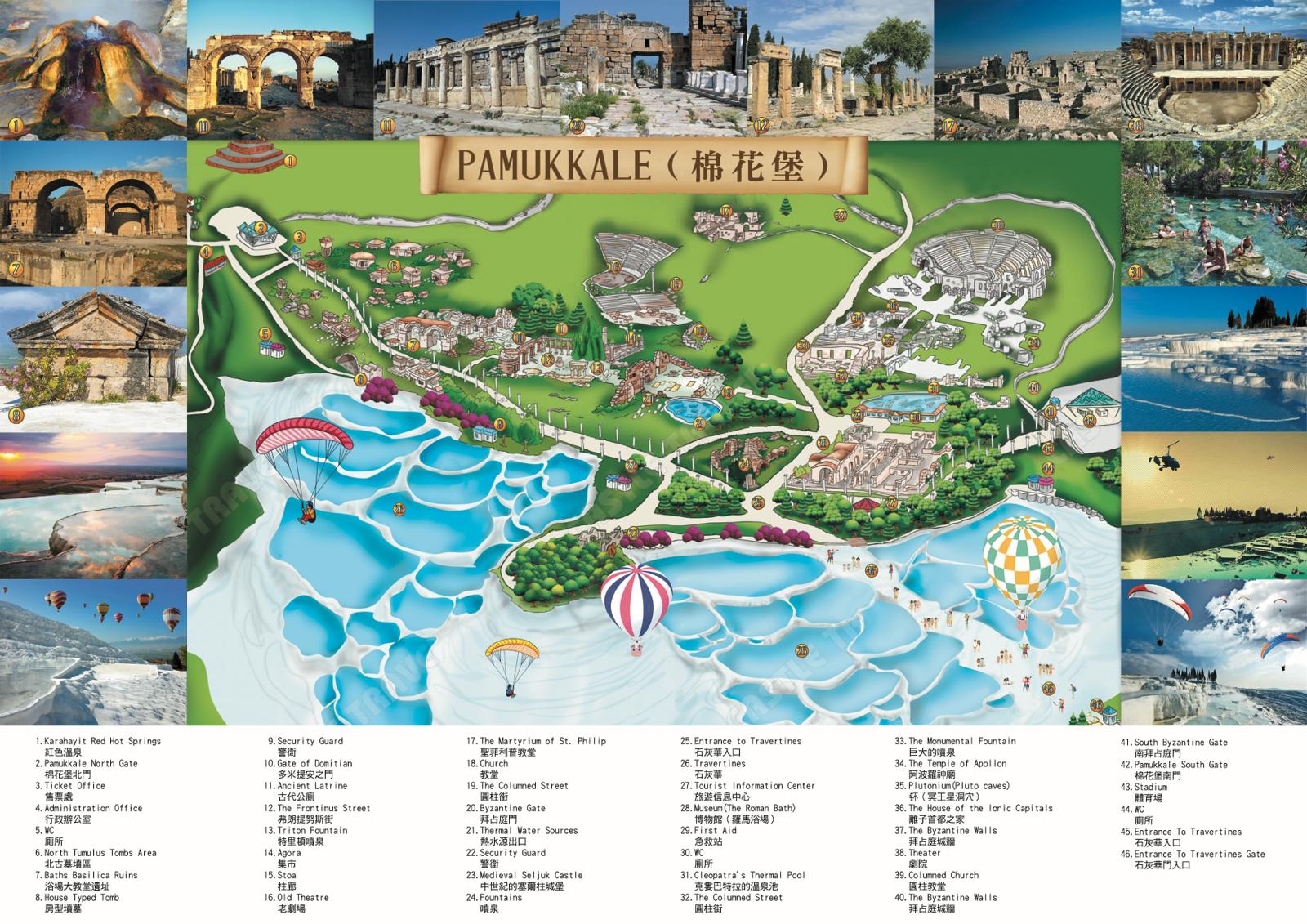
TEMPLE OF APOLLO
The Temple of Apollo had an oracle and was tended by priests. The source of inspiration for the Temple was the Plutonium spring located nearby, which gave off toxic vapours. The priests would use this to their advantage by demonstrated the potency of the mythological Hades, by sacrificing small animals into the Plutonium.
Only the foundations of the original Temple of Apollo remain. A new Temple was built in the 3rd century using a Roman style. The marble was recycled form the Temple of Apollo, but again, only the foundations remain.
PLUTONIUM
The Plutonium, located next to the Temple of Apollo, is the oldest local sanctuary and acted as a shrine to the god of the underworld; Pluto. It is a small cave, large enough for one person to enter, there are stairs leading down, where underground geological activity causes the emission of toxic carbon dioxide.
There is also fast-flowing hot water, with a potent smelling gas. Since people died from the toxic gas, it was thought that the god of the underworld was sending this gas to kill people. In the early years, priests crawled over, holding they're breath or by locating pockets of oxygen. This was seen as a miracle to the people and the priests were infused with superior powers and divine protection.
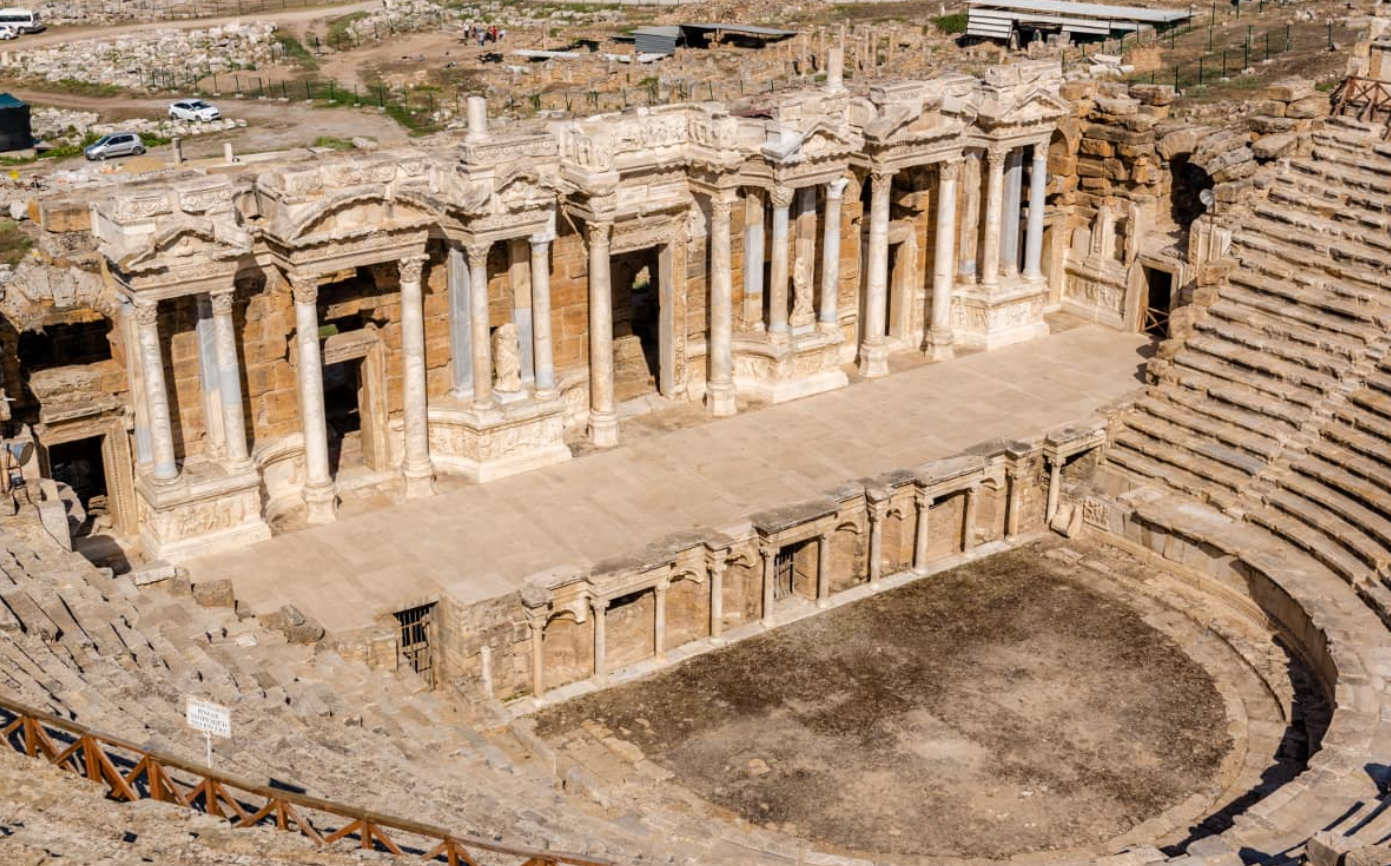
NYMPHAEUM
The Nymphaeum is a shrine of the nymphs, a fountain which distributed water to houses throughout the city, using a network of pipes. It is designed in a U-shape, with statues and shops around it, now only two side walls remain. The Nymphaeum had these retaining walls, which blocked the Christians view of the Pagan Temple.
MARTYRIUM OF ST PHILIP THE APOSTLE
This Martyrium was constructed in the name of St Philip, one of Christ’s twelve disciples. It is believed that St Philip was martyred here and is buried in the centre of the building. The arches of the eight individual chapels are marked with crosses and the views from here are amazing.
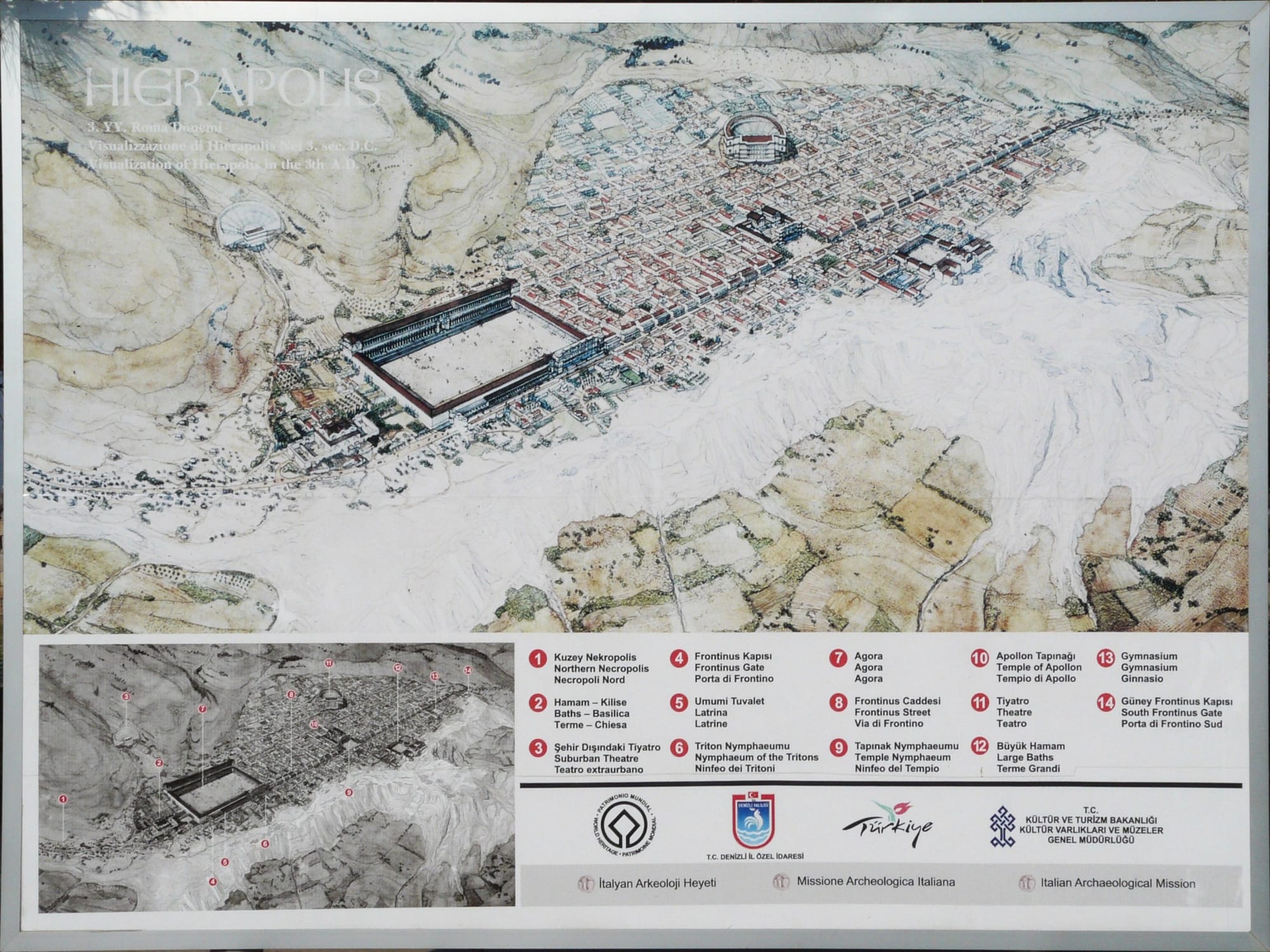
Visiting Cleopatra pool
Antique Pool
The thermal water in the Antique Pool is very important for human health besides the earthly goods and historical artifacts. Antique Pool
Especially in The Roman Empire period, Hierapolis and its side was exactly a health centre. In that years, thousand of people was coming to the Baths which are more than 15, and they find their remedy in that baths. Today’s Antique Pool was shaped by the earthquake which happened in A.D. VII. Century. The marble portic with Ionic arrangement have been fallen into the spring during the earthquake in VII. Century A.D.
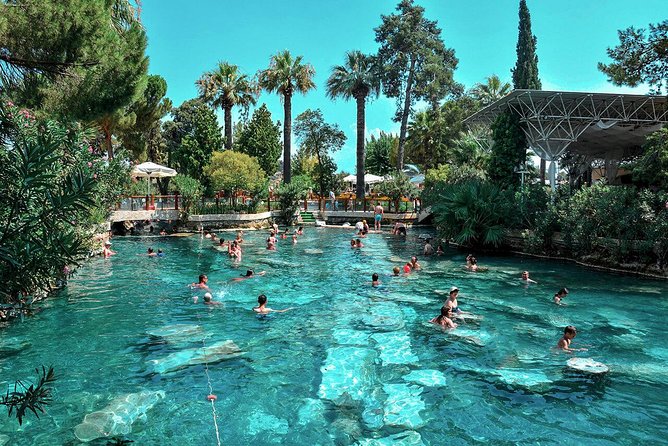
Up to the researchs, the Antique pools water is good for heart diseases, atherosclerosis, blood pressure, rheumatism, eye and skin diseases, rickets, nervous disorders, nervous and physical exhaustion circulatorly problems and furthermore when it has been drank it is good for digestive maladies. And all this benefits shows why so many health centers had been founded sides the Antique Pool from Roman Empire times on.
Free Time
Dinner and overnight accommodation
DAY 4 :
Having breakfast in the hotel and leaving for our last day
On our way back to Antalya
Visit Kibyra Ancient City
The residential area of the city is quite large. The buildings are symmetrically arranged, with a hilly terrace overlooking the lake and plain view, and no building blocks the view of the other.
When entering the city, there is a magnificent monumental gate on the left and the most magnificent stadium of Ancient Anatolia with a capacity of 12-13 thousand people. As you progress, you can see the basilica, the upper and lower agora, the bathhouse, gymnasion, the theater and the parliament building, the planned mausoleum, the bathhouse, the arch with round towers and waterways.
The assembly building / music house is one of the most magnificent works of Antiquity Anatolia with a capacity of 3,600 people. The Medusa Mosaic, made of red, green and white marble in the center of the assembly building / orchestra, with its hair made of snakes and its gaze that turns people into stone, is unique in Anatolia.
In 2011, a mosaic covering an area of 540 square meters, which is the strongest and largest mosaic area of Anatolia, was unearthed in front of the parliament building. Again, in front of the parliament building, a Roman Bath and a ceramic workshop from the Late Roman Period (6-7th century AD) were found. All the architectural remains of the city that can be seen today belong to the Roman Imperial Period.
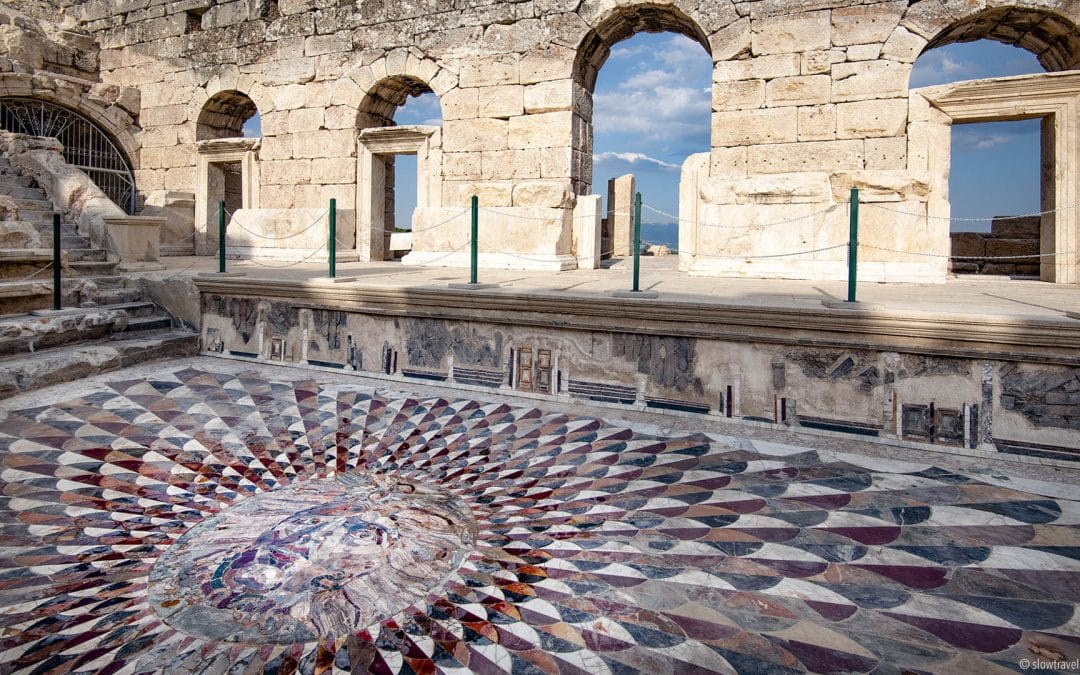
Kibyra, II. Eumenes (197-159 BC) seems to be under the rule of the Kingdom of Pergamum.
Immediately afterwards, a joint council of four, consisting of the ancient cities Boubon, Balboura and Oinoanda located in Kibyra and its vicinity, was formed (in the 2nd-1st century BC).
The unit in question was dissolved and destroyed by the Roman General Murena in 82 BC; Asia state and other cities were included in the Lycian Union.
The city, which was destroyed by a big earthquake in 23 AD, was rebuilt by the Roman Emperor Tiberius. Kibyra experienced its most brilliant period, especially between the 1st and 3rd centuries AD.
Arrival Antalya and transfer to your hotels
PRICE INCLUDES:
*Hotel pick up-drop off
*Hotel with half board (Only breakfast at the hotel is included )
*Guidance
*Entrance fees
OPTIONAL EXTRAS:
All meals and drinks are not included.Only breakfast at the hotel is included
Important information
Please note that all times are approximate and subject to change.
The Guide may make corrections and adaptations in the course of the tour program according to the conditions and situations of the planned places of visits
Bring your bathing gear and sunscreen.
Bring a hat.
Not suitable for people in wheelchairs
Are you looking for a different Turkey tour?
Please check our other Turkey Tours for inspiration or send us an E-MAIL with details of your dream Turkey trip such as your ages, hotel preferences, personal interests and travel type. We will get back to you with a suitable itinerary.
Contact us to get a personalized day by day itinerary for your trip to Turkey.
Benefit from our expertise.
We offer tailor-made tours to Turkey for all interests and desires, from romantic honeymoons and scenic self-drive road trips to photo tours with experienced photographers and cultural tours in major destinations.
We arrange everything for your turkey tours , including hotel bookings, airport transfers, guided tours, and top-notch experiences.
We want you to have a great time in Turkey and make sure your trip is a memorable one as we have escorted so many tours in Turkey personally.
At your request, we can take care of all the procedures relating to reservations (hotel, car, etc.), transfers (airport-hotel) and other additional services depending on the type of stay chosen.
For more information or reservation please contact us by mail or WhatsAap


